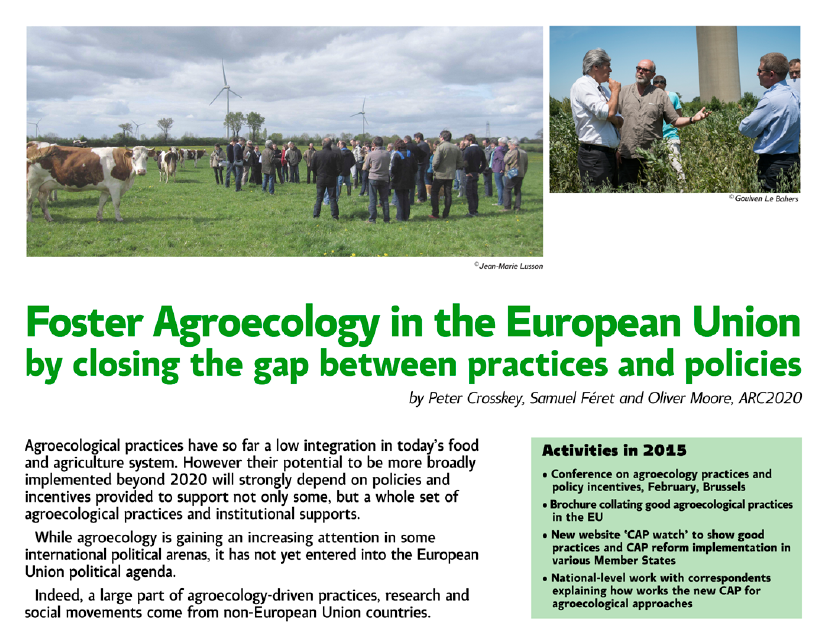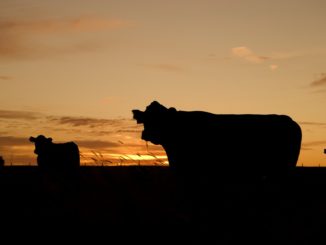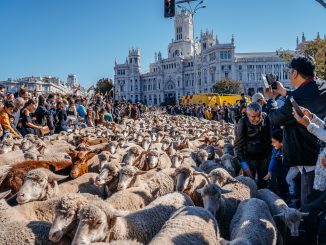
Karin Ulmer of APRODEV report on the FAO agroecology international symposium held in Rome.
“Agroecology is a promising paradigm and one of the alternatives to the green revolution which is starting to show its weaknesses”. FAO Director Jose Granziano da Silva.
The first FAO Symposium on Agroecology took place on 18-19 September 2014 in Rome with scientists Pablo Tittonell, Wageningen university (NL) and Stephen Gliessmann, University of Santa Cruz (US) leading through the programme.
Pablo Tittonell suggested that conventional agricultural systems need a fundamental redesign. He argued that farms need to be conceptualized as dynamic networks based on organised diversity in a complex environment. Productivity needs to be redefined, looking at farm landscape productivity rather than at yield gaps of individual crops. He refers to common knowledge that hunger is not the result of productivity but the result of poverty and inequality, as modest WHO figure suggest world food produce of 2720 kc per person per day while only 1800-2100 is required (indeed other figures suggest up to 4600 kc food produced globally). And 50 percent of this food is produced by small-scale farmers on only 20-30 percent of land in countries where yields are low and farms are small and women are majority of active farmers; most of this food is not traded internationally but sold on local markets.
There is a need to unpick the claims made by conventional agriculture. According to Tittonell, the most productive countries like US and EU together only contribute 12 percent to total food production and the highest efficiency loss occurs in maize production. An Elsevier article compares yields in agroecological and conventional farming which shows a mere 20 percent yield gap. At the same time, the investment in organic farming Research and Development is tiny, especially when compared to conventional farming’s investment rates: how is agroecology to ‘catch up’ with such meager investment in improving its performance?
An illustrative figure presented by Tittonell is for example, showed that a country like the Netherlands provides 5 million Euro for research on organic farming, with Monsanto investing a giant amount of 980 million Euro in research.
Findings by researcher Miguel Altieri, Berkley university (US), show that indigenous people like the Chinampas who run Aztec based management systems based on agroecological principles resulting in maize yields of 3,5 to 6,3 tonnes per hectare, allowing to feed 15 to 20 people. While back in the 1960’s, the US only harvested 2,3 tonnes maize per hectare.
Pablo Tittonell and Etienne Hainzelin, CIRAD (F) looked into new indicators needed for better understanding agroecology. And its contributions to farming, food and environment.
They emphasised a shift from:
- Yields land efficiency to land equivalent ratios.
- Yield gap potential to farm and landscape productive gaps.
- Nutrition flows and balances to nutrient networks, recycling and ascendancy.
- Efficiency as input and output ratio to efficiency as scale dependent energy proponent in a matrix.
- Calories to nutritional elements over time.
Gaetan van Locqueren, University of Louvain (BE), presented research into socio-economic impacts. This showed that agroecological methods have been adapted by thousands of farmers and that revenue per hectare is highly beneficial, and income return on labour can triple compared to conventional practices.
Examples include
- Young men finding attractive new jobs introducing the “Zai” system in Burkina Faso.
- Women farmers improving their earnings in milk production feeding ‘weeds’ (a range of grasses, herb and plants) to their cows.
- Rural women becoming managers of community seed banks.
- Young people running nurseries for seedlings in agroforestry.
Agroecological practices show positive income, lower bills and an improved balance of payments thanks to saving in inputs such as fertilizer, seed, petrol, machinery, etc. Positive externalities are created in the field of health and nutrition. Resilience to hurricanes and extreme weather is increased. Farmers build up knowledge, they reallocate surplus and create wealth and they decrease their dependency on price volatility in the global markets.
Daphne Miller, University of California (US), talked about diverse farming systems providing for diverse healthy diets. Traditional diets lead to lower health disease and build up ‘ethno-pharmacy’ or ‘farm-acy’. American natives in Mexico cultivate the ‘three sisters’ of corn, squash and over 300 species of beans providing a balanced and healthy diet. Gatherers of wild blueberries in Sweden receive omega 3 fats for free. Horta Hunting of wild greens in Crete collect free food in perennial gardens and protect their soil and avoid iron deficiencies.
Miller argued that agroecological approaches promote biotic diversity in the soil and allow for inter-biome communication. New microelectronic technologies allow for comparisons of environmental (microbiome) DNA of soil bacteria with bacteria in human stomach and intestine. The results are fascinating and show a clear correlation for “we are what we eat”.
Other speakers and soil scientists call for amplifying biogeochemical cycles through enhanced ‘underground biodiversity’, and learning about the incredible community of soil micro-organism and soil mineral surfaces. Researches in India and Africa referred to practices by indigenous people who leave sacred land untouched which turn into gene poles allowing locals to multiply and grow vast diverse food crops.
Lead scientist Tittonell and Stephen Gliessmann concluded that agroecology is happening on the ground, to some extent irrespective of the politics of today. They recalled that slavery was subsidized and enabled by policies and tools but eventually abolished. Times are changing and the problems of the food crisis will become more apparent. New initiatives emerge like the call by Paula Higgins to sign up to an International Ecocide Law. Countries like Brazil develop national agroecological plans. China is tapping into its huge organic knowledge of previous decades.
Major challenges identified by Tittonell and Gliessmann include the need for data, including via survey, to better understand how widely agroecology is already applied. Relevant categories need to be defined and guidelines drafted that describe agroecology as a set of principles that combine social and ecological indicators with collective action, aiming at reconnecting the rural and the urban, the producer with the consumer (‘prosumer’). Caution is needed to realize that agroecology can help to build resilience to climate change, but as climate keeps changing, agroecology will also need to keep changing and adapting to new situations. Another challenge is to reflect on how to deal with the official industrial agricultural system. One way is to deal with it separately in order to correct the massive negative external environment impacts of conventional agriculture. Vigilance is needed to prevent any exploitation of agroecology as a mere new toolbox for old industrial approaches.
Both identified many questions that remain open. For example, what kind of science and education is needed to support agroecology? What articulation do cities need to address energy use and nutrient recycles? What kind of public funding must be made available and is indispensable? What new legislation is needed? What are the responsible alternative food chains and consumers? And how can agrocecology attract young and new people to farming?
Jose Granziano da Silva responded positively to the call by scientists to FAO Member States and the International Committee to build a UN wide system on agroecology, addressing climate change and resilience, inviting joint work by scientists, smallholder farmers and civil society.
In conclusion, the statement by Gliessmann that ‘What we need to do is in our hands’ is an empowering one. The Symposium provided scientific evidence substantiating the call to unpick the claims of conventional agriculture to feed the world. In fact it does not feed the world and is not well placed to do so. Figure and facts presented at the Symposium will hopefully be documented in the forthcoming FAO report providing the necessary scientific evidence and sources. Such a report could possibly present a kind of baseline of the state of play of agroecology. The report should also include definitions and guidelines on agroecology preventing it from being reduced to a mere new toolbox for industrial agriculture.
But there is also a major challenge that agroecology has to invest itself in re-thinking scale and scope and the spread of practices beyond the local and the community. This would enable it to present itself as valid paradigm for transforming the current dominant food system.
This conference represented an important acknowledgement of agroecology at the global level. The next step is for a global agroecological platform to be established, to help address the significant challenges ahead.





De Schutter relies on alogecoorgy, which claims to be the application of ecological science to sustainable agriculture. However, alogecoorgy is unable to contribute to two apparent paradoxes of global food production: 1) most of our food, from small plots of rice to vast fields of soyabean, comes from monocultures supposedly biologically unstable; 2) most food, certainly Latin America and Africa, comes from introduced, and not native, crops. But alogecoorgy would suggest that local crops are locally adapted, and therefore somehow better than introduced crops.Until alogecoorgy can explain these two paradoxes it should remain a harmless academic study, rather than an untried and dangerous approach to feeding people.